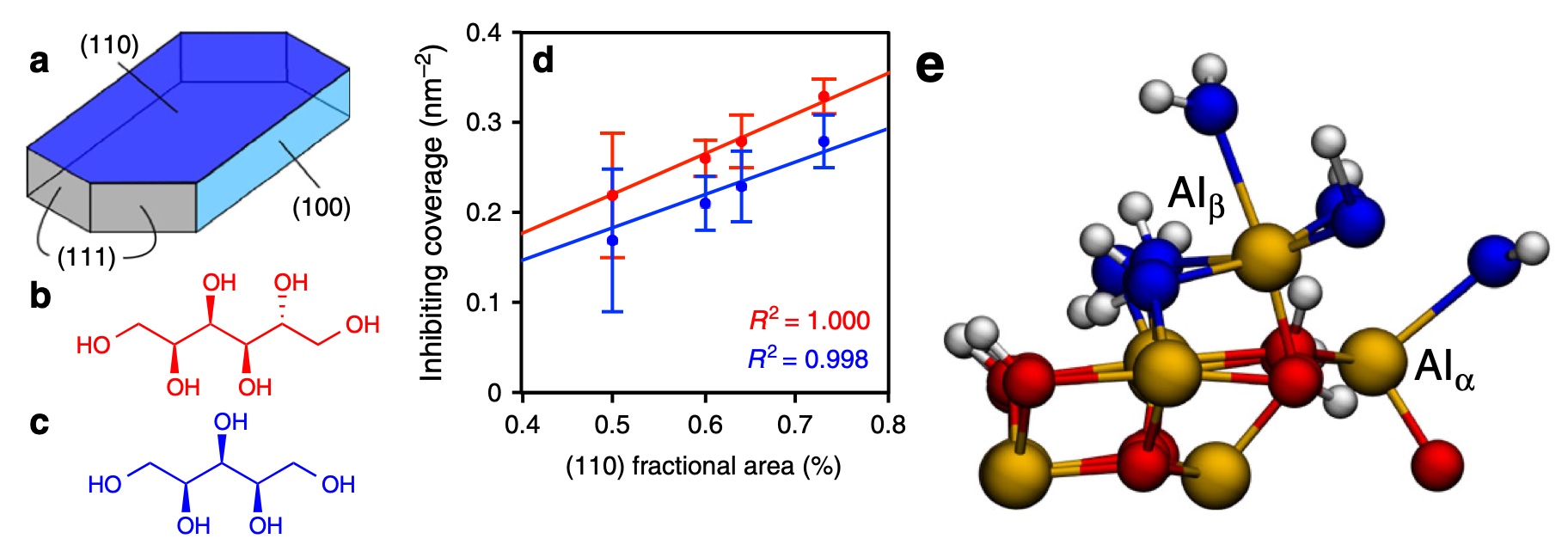Mechanistic investigations at the alumina/water interface
γ-Al2O3 has remarkable properties as a support, but it is very sensitive to water, either as a liquid[1] or even as steam[2]. These structural changes can be retarded by the presence of polyols.[3] The mechanism of action of these additives is believed to lie in their chemisorption on the surface that would make γ-Al2O3 water-resistant[3]. However, little is known on which exposed facet(s) and what site(s) need to be particularly targeted for protection. The optimization of the structure of inhibitors is therefore a challenging task since the exact mechanism of the decomposition of γ-Al2O3 in liquid water remains unknown. We combine here experiments and theory to provide the atomistic mechanism for the early-stage decomposition of γ-Al2O3 in liquid water,[4] but also for the adsorption/desorption mechanism of (poly)-alcohols at the γ-Al2O3 / water interface.[5]
Alumina samples containing particles with different shapes were exposed to a hydrothermal treatment in presence of various concentrations of polyol (sorbitol and xylitol, Figure 1b and 1c). We determined the minimum surface coverage of polyol at which the decomposition of alumina gets inhibited, a quantity referred to as inhibiting coverage. Since this inhibiting coverage strongly correlates with the fractional area of the (110) facet of the alumina sample and only with this area, we concluded that the decomposition is initiated at the (110) facet (Figure 1d). Then, performing ab initio metadynamics simulations using cp2k, we probed the reactivity of this Al2O3(110)/water interface and identified specific aluminum tetrahedral centers that are particularly reactive with water. We showed that interfacial water molecules are involved in the mechanism, both as reactants for the hydration of aluminum and as intermediates for the proton reshuffling required by the decomposition mechanism. We managed to determine the barriers (all lower than 80kJ.mol-1) for the 6 successive addition/elimination steps in a single simulation and the resulting final structure is shown in Figure 1e. Furthermore, the effect of xylitol was rationalized: its adsorption locally rendered the surface more hydrophobic and pushes water molecules away from the Al sites identified as water-sensitive.[4] Then, we investigated in details the adsorption/desorption mechanism of (poly)-alcohols at the γ-Al2O3 / water interface and found that liquid water induces a barrier of at least 20kJ.mol-1 due to the substitution of chemisorbed water and the solvent reorganization.[5] Beyond its impact on the stability of this important support, the present achievement constitutes an unprecedented milestone in the understanding of solid/liquid interface transformation in term of methodology.

Figure 1. a. Typical γ-Al2O3 platelet; Inhibitors: b. sorbitol c. xylitol; d. Correlation between the inhibiting coverage and the fraction of exposed (110) ; e. Side view of the last intermediate obtained from the hydration of tetrahedral Alβ exposed on (110) during an ab initio metadynamics of the γ-Al2O3(110)/water interface. O from γ-Al2O3 in red, O from water in blue, H in white, Al in yellow.
[1] Ravenelle, R. M., Copeland, J. R., Kim, W. -G., Crittenden, J. C. and Sievers, C. ACS Catal. 1, 552 (2011). [1] Sakwa-Novak, M. A. and Jones, C. W. ACS Appl. Mater. Interfaces 6, 9245 (2014). [3] Ravenelle, R. M., Copeland, J. R., Van Pelt, A. H., Crittenden, J. C. and Sievers, C. Catal. 55, 162 (2012). [4] Réocreux, R., Girel, É., Clabaut, P., Tuel, A., Besson, M., Chaumonnot, A., Cabiac, A., Sautet, P. and Michel, C. Comm. 10, 3139 (2019). [5] Clabaut, P., Rey, J., Réocreux, R., Steinmann, S. N., and Michel, C., ChemRXiv, 10.33774/chemrxiv-2021-n77jn ; (2021). [6] Réocreux, R., Jiang, T., Iannuzzi, M., Michel, C. and Sautet, P. ACS App. Nano Mat., 1, 191, (2018)